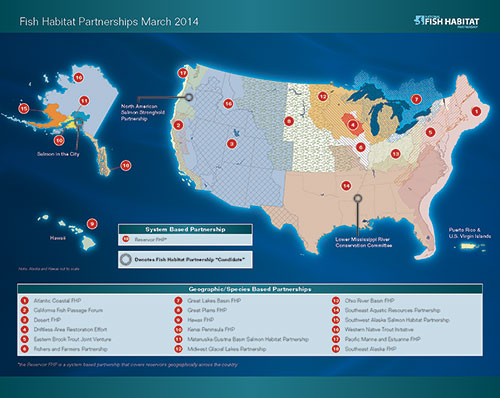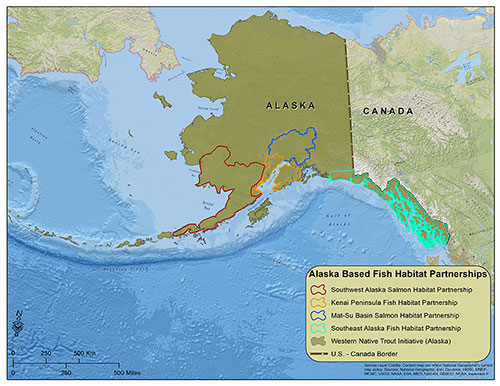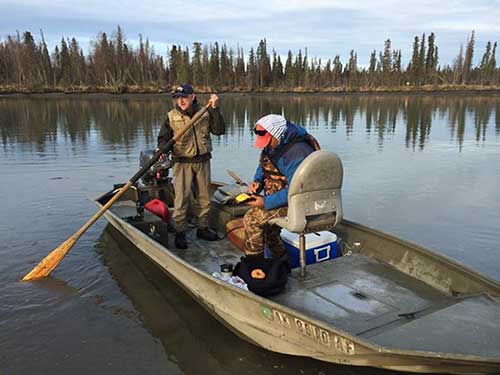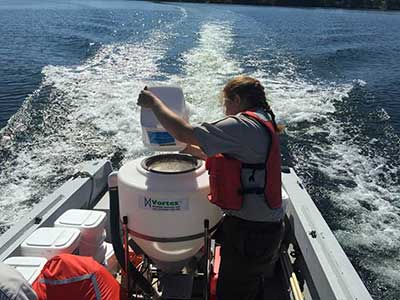Alaska Fish & Wildlife News
September 2015
An Introduction to National Fish Habitat
Partnerships in Alaska

The Alaska Department of Fish and Game (ADF&G) participates in several programs that contribute to the conservation (protection, restoration, and/or enhancement) of fish and their habitat. Examples of the more commonly known programs include maintaining and updating the Anadromous Waters Catalog (AWC), collecting hydrologic and other data to develop reservations of water, ensure habitat connectivity by installing new culverts and repairing/replacing older culverts to maintain, restore or improve fish passage, and minimizing and avoiding impacts of development through the department’s various habitat permitting processes. The National Fish Habitat Partnership (NFHP) represents one of the lesser known fish habitat conservation programs ADF&G is involved with at the local, state, and national levels. This article provides background and the benefits of NFHP, the role of the department, and a description of the five Fish Habitat Partnerships (FHPs) currently operating in Alaska, including potential funding opportunities that each of these FHP’s offer.
The National Fish Habitat Partnership program, guided by the National Fish Habitat Action Plan (2006) and the revised 2012 Edition, is a voluntary nationwide effort to arrest and reverse the nation’s loss and degradation of freshwater, marine, and estuarine fish habitat. The mission of NFHP is “to protect, restore and enhance the nation's fish and aquatic communities through partnerships that foster science based fish habitat conservation actions and improve the quality of life for the American people”.
NFHP is made up of a network of 19 FHPs throughout the U.S. that were voluntarily established through organic efforts of local, private, state, federal, tribal, and non-governmental organizations (NGO). The FHPs were formed to promote the NFHP mission and to work within a specific geographic area or select group of fish species [Figure 1]. Under the guidance of a national oversight board (NFHP Board), NFHP fostered the bottom-up development of these Fish Habitat Partnerships, each of which had to develop a strategic plan and get formal approval by the NFHP Board. One summary widely used to explain NFHP’s focus is: conserve fish habitat nationwide using volunteer stakeholder actions and leveraging federal, state, tribal, and private funding resources to achieve the greatest impact on fish populations through priority conservation projects.
The NFHP effort began in 2001 when the Sport Fishing and Boating Partnership Council supported an effort to explore the concept of developing a habitat partnership program for fish on the scale of what was done for waterfowl in the 1980s through the North American Waterfowl Management Plan. By most accounts, the waterfowl plan has worked wonders during the past two decades to boost waterfowl populations by forming strong local and regional partnerships to protect key habitats.
The ability to cost effectively address fish habitat protection, restoration, and enhancement needs throughout Alaska extend beyond the capacity of any one local, state, federal agency or conservation group. At the same time any effort to conserve fish habitat also requires the support, field and analytical expertise, and other scientific resources that ADF&G provides. Accordingly, department staff members are actively participating in each of the FHPs acting as science and technical advisors and contributing to conservation projects (Table 1). A part-time ADF&G statewide FHP coordinator position has been funded for the last several years through USF&WS and National Fish and Wildlife Foundation (NFWF) grants. This position provides a link between the FHPs and the department by serving on steering committees or as an advisor working to ensure FHP projects are aligned with ADF&G goals and are science based actions beneficial to the state. An important point to remember is that ADF&G played a key role in the creation of NFHP because of the strong socioeconomic significance of fish to the Alaskan economy. Past and current ADF&G senior staff members have also been actively engaged with NFHP at the national level serving on various planning teams. It should also be noted that the former Special Assistant to the Commissioner Kelly Hepler was appointed to the original NFHP Board and was later appointed its chair and is still serving in that capacity (Kelly is now the Secretary of the South Dakota Department of Game, Fish and Parks

There are many benefits the department receives through its involvement with the National Fish Habitat Partnership and Alaska Fish Habitat Partnerships, beyond the most obvious of cost effectively conserving fish habitat. In collaboration with USF&WS and FHPs, ADF&G staff has not only promoted the NFHP goals but has also helped utilize non-state funds to advance core services of the Divisions of Habitat and Sport Fish. An often overlooked benefit of working with FHPs is that the collaborative structure of NFHP greatly improves the lines of communication between the department and other agencies and stakeholders. It was pointed out a few years back by ADF&G leadership that often the only thing the department and some federal agencies agree on and collectively support is the fish habitat conservation work the FHPs are accomplishing.
The five FHPs operating in Alaska (Figure 2) are part of a national network that shares the common goal to conserve (protect, restore, and enhance) fish habitat. The Mat-Su Basin Salmon Habitat Partnership (Mat-Su Partnership) and Southwest Alaska Salmon Habitat Partnership (SWASHP) focus primarily on salmon habitat while the Kenai Peninsula Fish Habitat Partnership (KPFHP) and Southeast Alaska Fish Habitat Partnership (SEAKFHP) focus on conserving fish habitat for species that at some point in their lifecycle depend upon the freshwater, estuarine, and marine ecosystems within their respective geographic boundaries. While not physically based in Alaska, the geographic range of the Western Native Trout Initiative (WNTI) encompasses all of Alaska and 11 other Western states and primarily focuses on native trout and char. Currently seven native fish in Alaska are on WNTI’s “species of concern” list: coastal cutthroat trout, Arctic char, Arctic grayling, Dolly Varden, coastal rainbow trout, kokanee and lake trout.
Each of the Alaska FHPs is comprised of numerous partners representing local, state, federal, and tribal agencies as well as other private individual, corporate, and NGOs interested in fish habitat conservation. As each FHP matures more partners are added, which expands the diversity of interests, expertise and capacity of the FHPs, or fills a geographic gap in representation. The following is only a partial list of partners but helps illustrate the range and depth of Alaska FHPs: Alaska Departments of Environmental Conservation, Natural Resources, Fish and Game, and Transportation and Public Facilities; local government representatives, including the Mat-Su Borough, federal agencies – U.S. Fish and Wildlife Service (USF&WS), National Oceanic and Atmospheric Administration, Bureau of Land Management, U.S. Army Corps of Engineers, U.S. Geological Survey, National Park Service, and U.S. Forest Service; NGOs including Soil and Water Conservation Districts, The Nature Conservancy, Trout Unlimited, The Conservation Fund, various land trusts, tribes and tribal organizations including the Tyonek Tribal Conservation District, watershed councils, Native Corporations, including Sealaska Corporation, Alaska universities, aquaculture associations, science centers, and sport and commercial fishing groups. Partners also include some of the big name retailers in the outdoor recreation industry as well as in the resource development arena (i.e., ConocoPhillips Alaska, Inc. (Mat-Su Partnership).
The majority of annual federal funding used to support NFHP and the individual FHPs currently comes from the USF&WS. The funding is administered and distributed by the service with input from the NFHP Board with approximately $3.0 million annually used to support FHPs and fund fish habitat conservation projects; leveraging additional in-kind funding and services from partners greatly expands individual FHP resources. One of the annual tasks of the individual FHPs is to solicit, score/rank, and recommend various project proposals to the USF&WS and NFHP Board for funding. The level of funding each FHP receives is based on a competitive process, and in 2015 both the Mat-Su and Southwest Alaska Salmon Habitat Partnership were awarded $236,000 while the Kenai Peninsula Fish Habitat Partnership and Western Native Trout Initiative each received $128,000. The Southeast Alaska Fish Habitat Partnership is not currently eligible to receive USF&WS funding because it has only been in existence since 2014, but a portion of its funding need is being supported by the USF&WS and the US Forest Service. ADF&G is eligible to receive funding from FHPs to support projects to conserve fish habitat. One example of an ADF&G/FHP partnership is the current Mat-Su Partnership’s financial support of the elodea eradication project in Alexander Lake. For more information on the Request for Proposals (RFP) currently open for 2016, please see the individual links provided in Table 1 to review the scope and application process. A brief description and some of the highlighted accomplishments and future goals of each of the Alaska FHPs are described below.
Mat-Su Basin Salmon Habitat Partnership

The Matanuska-Susitna (Mat-Su) Basin Salmon Habitat Partnership believes that thriving fish, healthy habitats, and vibrant communities can co-exist. Because wild salmon are central to life in Alaska and in the Mat-Su Basin, this partnership works to ensure quality salmon habitat is safeguarded or restored. Since its inception, the Mat-Su Partnership has funneled $837,613 of NFHP funds to support projects with matching contributions of $2,531,153 bringing the total investment in fish habitat conservation to $3,368,766. Reducing habitat fragmentation has been a top priority in their Strategic Action Plan and the partnership has had great success working with the Mat-Su Borough to successfully remove 17 fish passage barriers on high priority salmon streams by the Mat-Su Borough and other partners, opening 54 miles of upstream habitat and access to 604 acres of lakes. The Partnership is also working with partners and private landowners to voluntarily protect nearly 6,300 acres of estuaries, wetlands, riparian areas, vital for salmon spawning and rearing and sustaining healthy salmon populations in the Valley. Other priority actions have included:
1) Water quantity: three applications were filed for instream flow protection with ongoing data collection on two additional streams; and
2) Stream Protection: 180 miles of streams have been added to the AWC improving information about salmon distribution and affording streams the protections under state law that comes by being listed. The Mat-Su Partnership’s habitat restoration projects led to an assessment of 567 fish-bearing road-stream crossings of which 70 percent were found to prevent or limit salmon from reaching spawning and nursery habitats.
The Mat-Su Partnership is working to fill data gaps in order for fishery managers to respond to state listed stocks of concern, including Cook Inlet Chinook salmon, and to provide a forum and strategic plan to efficiently pool resources and expertise to sustain salmon. Based on the updated Strategic Action Plan and building on its past success, the Partnership will focus the $236,000 of NFHP funding in 2015 to support priority projects in the Mat-Su basin including:
1) Science & Assessments
2) Habitat Protection
3) Habitat Restoration
4) Sustainable Operations.
Mat-Su Partnership will be accepting project proposals for 2016 until September 23, 2015 for projects in support of salmon habitat conservation activities and priorities as identified in the Mat-Su Salmon Partnership Strategic Action Plan.
Southwest Alaska Salmon Habitat Partnership
The Southwest Alaska/Bristol Bay area arguably supports the most vibrant populous sockeye salmon stock complex in the world thanks to its largely intact fish habitat. Protecting the integrity of the mosaic of intact habitat is central to sustaining Southwest Alaska’s fisheries so future generations of Alaskans and non-Alaskans can benefit from the uniqueness of a region that has changed little since time immemorial.
Since receiving formal recognition by the NFHP Board in 2008, SWASHP has received $802,890 in USF&WS/NFHP funding. Prior to 2008, SWASHP received a competitive grant award of $100,000 to initiate the collection of date required to file instream flow reservations on the Stuyahok and Mulchatna Rivers. Various NGO partners, including The Conservation Fund, The Nature Conservancy, Bristol Bay Native Association, Trout Unlimited and the Bristol Bay Heritage Land Trust, have leveraged an additional $17,620,000 in funds. In a testament to the relevance and importance of partnerships, consider this: since 2008, SWASHP estimates that for every dollar invested by NFHP to protect salmon habitat in Southwest Alaska, NGO partners have raised approximately $28 from a variety of other government programs and private sources. Most important are the direct protection accomplishments by partners since recognition in 2008 that include:
1) in excess of 25,000 acres conserved by fee acquisition or conservation easement
2) over 400 miles added or nominated through the AWC
3) priority instream flow reservations under Alaska law for fish on five important anadromous river systems (Mulchatna River, Stuyahok River, Koktuli River, Kaskanak Creek and the Chulitna River).
In 2015, SWASHP received $162,400 to launch a five-year effort to establish monitoring sites and collect baseline water quality, macroinvertebrates, fish and other environmental information. The project will improve the understanding of the aquatic ecosystem at the headwaters of Bristol Bay’s two most productive sockeye and Chinook watersheds, the Nushagak and Kvichak drainages. The collection of a long-term dataset should help partners distinguish natural variations in these aquatic communities from climate change or human induced impacts.

The SWASHP is once again seeking project proposals and ideas for 2016 from all partnership organizations that have continuing funding needs for projects that were initiated through the partnership and support conservation activities and priorities identified in the Strategic Action Plan. Project descriptions are due via email by close of business on September 30, 2015.
Kenai Peninsula Fish Habitat Partnership
KPFHP focuses on healthy fish, healthy people, and healthy Kenai Peninsula economies and works to conserve healthy fish populations through support from a diverse group of partners. The two most important achievements to date of the KPFHP member groups include leading efforts to remove the Kenai River from section 303(d) impaired water body status (caused by use of older inefficient outboard motors in a high density recreational fishery) and communicating the importance of the Kenai Peninsula Borough effort to achieve full implementation in 2014 of a 50’ Riparian Habitat Protection Zone instated throughout the KPFHP boundaries (i.e., a restricted development zone for all land within 50’ of anadromous waters as cataloged by ADFG). This ordinance was instituted and upheld by the local Kenai Peninsula Borough Government in an area that has no other zoning regulations. The members of the KPFHP also provided expert testimony when called upon by the Borough and helped the decision makers with understanding the links between salmon and the nearshore riparian environment.
In the three-year period since formal recognition, 12 specific NFHP funded projects have been advanced by the partnership. These projects consisted of one restoration effort, seven assessments, three education and outreach projects and one community scoping effort for subsequent removal of invasive pike. Elodea, a highly injurious aquatic invasive species that poses an immediate and immense threat to aquatic-fisheries resources, was discovered on the Kenai Peninsula in 2012. The KPFHP has identified invasive species as one of our top threats to fish habitat and are directly supported multi-agency efforts led by the Kenai Peninsula Central Weed Management Area group to completely eradicate known elodea occurrences with chemical treatments and to prevent future spread of elodea to other locations with targeted public outreach and education. Efforts to eradicate elodea are ongoing and successful to date. In 2015, KPFHP received approximately $128,000 of NFHP funding to support projects that address the priority threats as developed by their science teams and described in the Freshwater and Marine Conservation Action Plans (CAPs). In early September 2015, KPFHP will release its RFP for 2016 project proposals which will be due in early October, 2015.
Southeast Alaska Fish Habitat Partnership
The SEAKFHP works to foster cooperative fish habitat conservation in freshwater, estuarine, and marine ecosystems across the southern panhandle of Alaska including the dynamic watersheds and waterways that make up the Alexander Archipelago. The SEAKFHP was formally recognized in March, 2014 as the 19th FHP. The SEAKFHP has finalized its strategic action plan capturing regionally supported fish habitat conservation goals and objectives for the region. Recent highlights and accomplishments include:
1) hosting the 1st annual Alaska Fish Film Festival bringing together over 20 films capturing the importance of fish and their habitats in Alaska
2) organizing a Southeast Alaska Watershed Symposium
3) co-sponsoring America’s Fish and Fisheries – Shared through the Camera Lens a film festival held during the American Fisheries Society’s 145th Annual Meeting in Portland, Oregon
4) elevating existing regional aquatic conservation assessment and research information and strengthening connections with the NFHP Science and Data team.
Future priorities include organizing and hosting a multi-day fish passage workshop (Oct. 13-15, 2015) to examine the plans, policies, and practice of fish passage management in the region.
Western Native Trout Initiative
The Western Native Trout Initiative is a public-private FHP that works collaboratively across 12 western states to conserve (protect, restore and recover) 21 native trout and char species. WNTI represents a collaborative, multi-state approach that provides a new perspective and impetus to improve the return on investment of the time, money and manpower dedicated to native trout conservation. In 2010, WNTI amended its strategic plan to include 6 more native species in Alaska on its “species of concern” list; coastal cutthroat trout was already on this list. The historical range of these species encompasses the entire state of Alaska. Through this action WNTI not only became a partner with all of the Alaska based FHPs but extended eligibility to the entire state for WNTI/NFHP funds. WNTI is actively making efforts to help fund projects throughout Alaska. However, WNTI’s desire to conserve fish habitat for these Alaskan species is an important link for areas in Alaska that are not geographically included by the other 4 recognized FHPs. WNTI anticipates an increase in available funding over the next few years and hopes to be more active in collaborating with the Alaska FHPs.

Between 2006 and 2014, WNTI has directed over $4 million in federal fish habitat funds leveraged to $14 million public and private matching dollars for 113 priority native trout conservation projects. Over eight years, with the collaboration and coordination of partners, WNTI has removed 48 barriers to fish passage, reconnected or improved 485 miles of native trout habitat, and constructed 26 protective fish barriers to conserve 570 miles of important native trout population habitats. Specific WNTI accomplishments in Alaska include restoring fish passage at Eccles Creek near Cordova, completing applications to reserve water for three trophy cutthroat trout lakes in Southeast Alaska, and contributing to a range-wide coastal cutthroat distribution and assessment (including Southeast Alaska and Prince William Sound). WNTI has also awarded several small grants (less than $3,000) in Alaska for projects such as bank restoration on Chester Creek (Anchorage), stream temperature monitoring on Kenai River, and contribution to the Kenai Watershed Forum’s Stream Watch program. WNTI just released information on its 2016 RFP that will be due by 5:00 p.m. Mountain time on Monday October 12, 2015.
Future of NFHP
Of national interest to the Alaska FHPs is the effort to once again include the National Fish Habitat Conservation Act with the Sportsmen’s Act of 2015 that was sponsored and introduced in the U.S. Senate by Senator Lisa Murkowski (R-AK). The Bipartisan Sportsmen’s Act of 2015 contains measures that would “benefit our nation’s sportsmen and women by providing increased access to our public lands and waters, improving fish and wildlife management and protecting the use of traditional fishing tackle.” The National Fish Habitat Conservation Act would authorize the National Fish Habitat Action Plan and establish the oversight duties of the National Fish Habitat Board. See http://www.energy.senate.gov/public/index.cfm/legislation?ID=ba3485d0-b3 for more information on the status of the proposed legislation.
The future of Alaska FHPs is bright and will continue to provide cost effective achievements in fish habitat conservation while complimenting important ADF&G core services. The department has applied for another NFWF grant to continue funding its part-time statewide FHP coordinator position. ADFG’s leadership supports promotion of the NFHP mission as well as department engagement with FHPs and emerging conservation groups to collaboratively work together to conserve fish habitat.
Roger Harding is retired from Sport Fish Division after 30 years and currently works part-time as the Coordinator for Fish Habitats Partnerships in Alaska and is funded entirely by a National Fish and Wildlife Grant.
| Name | Coordinator & ADF&G advisor | RFP Due Date |
|---|---|---|
| Mat-Su Partnership | Jessica Speed jspeed@tnc.org Sam Ivey samuel.ivey@alaska.gov | 9/23/2015 |
| Southwest Alaska Salmon Habitat Partnership (SWASHP) | Tim Troll nmwtlandtrust@hotmail.com Dan Bosch dan.bosch@alaska.gov | 9/30/2015 |
| Kenai Peninsula Fish Habitat Partnership (KPFHP) | Robert Ruffner robert@kenaiwatershed.org Ginny Litchfield ginny.litchfield.org | 10/1/2015 |
| Western Native Trout Initative (WNTI) | Therese Thompson tthompson@westernNativetrout.org Roger Harding roger.harding@alaska.gov | 10/12/2015 |
| Southeast Alaska Fish Habitat Partnership (SEAKFHP) | Debbie Hart coordinator@sealaskafishhabitat.org Jeff Nichols jeff.nichols@alaska.gov | |
| National Fish Habitat Partnership website | http://fishhabitat.org/ | |
| All Alaskan FHP website | http://www.akfishhabitat.org/ |
Subscribe to be notified about new issues
Receive a monthly notice about new issues and articles.
